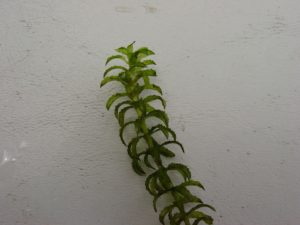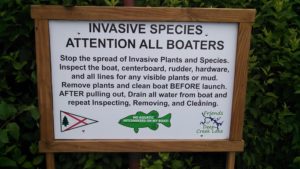From fish populations to vegetation, managing a pond or lake involves a lot of time and effort. Maintaining a clear pond or lake for recreational and other purposes can be a constant fight against nature. This can be especially hard when invasive aquatic plants make their way into ponds and lakes.
While they often appear harmless at the onset, letting these invasive aquatic plants remain can be devastating, not only to the pond’s ecosystem but also to the property’s aesthetic and recreational value.
Invasive Plants and Why They Matter
Invasive species are non-native species, that have been introduced accidentally or intentionally. After introduction, some of these exotic species can thrive in their new setting. Without natural predators or competitors, there is little in the way of stopping the spread of these invasive plants. Once they pose a threat to the health of the ecosystem or the humans around it, these exotic species are reclassified as invasive species.
While invasive animal species are quite common and can pose a danger to their surrounding ecosystems, invasive plant species are even more common and can be equally as devastating to their environment. They compete with native organisms for soil, water, nutrients, pollinators, light and space; pushing native plants out of the ecosystem along with any of their natural cohorts.
Invasive species can also crossbreed with native plants, further improving their acclimatization to the environment and their ability to spread. In general, invasive aquatic plants can disrupt and ruin an ecosystem.
When an invasive species spreads and dominates an ecosystem it is called a monoculture. Not only are these monocultures environmentally disastrous, but they can also impede human activity and recreation. Invasive species can grow over hiking and biking trails or choke out agricultural plants. Aquatic species can create impassible tangles in boating, fishing and swimming areas, presenting dangers to users. Although these issues make controlling these invasive species a crucial task, the amount of time, labor and money needed to do so is monumental. One estimate places the economic impact of invasive species at $142 billion annually.
For owners of aquatic property, aquatic invasive plants are particularly problematic. They pose dangers to people and their property by tangling in boat motors and rudders or latching onto swimmers and fishing gear. Aquatic invasive plants can even destroy fishing locations by pushing out or killing off native fish species.
Six Common Invasive Species
- Eurasian Watermilfoil (Myriophyllum spicatum)
- Yellow Floating Heart
- Hydrilla (Hydrilla verticillata)
- Parrot-Feather (Myriophyllum aquaticum)
- Water Chestnut (Trapa natans)
- Coontail (Ceratophyllum demersum)
To help prevent and manage an infestation before it takes over, aquatic property owners should be aware of the most problematic invasive aquatic species. Property owners should also be aware of the threats these species pose and how an experienced aquatic plant management team can help prevent and control them.
Here are six species to keep a vigilant watch for:
-
Eurasian Watermilfoil (Myriophyllum spicatum)
Part of the watermilfoil family, Halogoraceae, Eurasian watermilfoil escaped captivity in the 1940s to infest waters throughout the United States. Originally from the African and Eurasian continents, this herbaceous plant now inhabits over 33 states, primarily occurring in the eastern half of the country. It can be found primarily in brackish and slow-moving water and is commonly found in ponds, lakes and reservoirs.
Some identifying characteristics of Eurasian watermilfoil include:
- Long stems: The long, slender stems grow up to the water surface, branching and extending anywhere from three to thirty-three feet in length to form dense mats. These stems range in color from red-brown to a light pink.
- Feathery leaves: Bright green, two-inch leaves occur in whorls along the stems of Eurasian watermilfoil, split into 12 to 16 pairs of fine leaflets, giving the plant a feathery look.
- Flowers and fruits: The plant produces whorls of small reddish flowers with four parts. These appear on a spike that projects two to four inches above the surface of the water, remaining there until after pollination. The resulting fruit is a hard capsule containing four seeds.
- Dispersal: Rhizomes, fragmented stems, and axillary buds are the primary means of dispersal for Eurasian watermilfoil. These means are much faster and much more important than their dispersal via fruit and seed.
- Other characteristics: Eurasian watermilfoil is tolerant of many water pollutants, meaning it can establish in a wider variety of aquatic environments.
Eurasian watermilfoil tends to establish itself in disturbed areas where native plants have trouble getting established, such as the surface of slow-moving or polluted bodies of water. Because of its tendency to form mats, this plant species can effectively block sunlight from reaching native plants and can pose an impediment to water traffic.
An experienced lake treatment service team can properly identify a Eurasian watermilfoil infestation, evaluate the correct response, and develop a management program for balancing the environment. Depending on the specific situation, a variety of management techniques may be employed. These include using a combination of harvesting equipment and hand rakes to remove infestations from both large and small areas, as well as manipulating the environment with water colorants, physical barriers or special herbicides.
-
Yellow Floating Heart

Some identifying characteristics are:
- Stolons: Yellow floating heart is an aquatic, bottom-rooted perennial with long branched stolons extending up to one meter or more and lie just beneath the water’s surface. A new shoot and roots are capable of forming at each node on a stolon.
- Leaves: The floating heart has heart-shaped or nearly circular leaves that are 2-5 inches long on long stalks that rise up from the stolon. The leaves are frequently purplish underneath, with slightly wavy, shallowly scalloped margins.
- Flowers and fruits: The flowers, 1-2 inches in diameter, are bright yellow with five petals. The flower edges are distinctively fringed giving this plant one of its common names, fringed water lily. The fruit is a capsule up to one inch long containing numerous seeds. The seeds are flat, oval and about 0.1 inches long with “hairy edges.”
- Dispersal: Seed hairs help the seeds float and attach to waterfowl and animals, which can serve as a vector in spreading this plant to new areas. Viable seeds are produced abundantly and germinate readily and broken leaves with attached stem parts can form new plants.
Plants most likely confused with yellow floating heart are spatterdock and watershield. Spatterdock has a large yellow “cup-shaped” flower and leaves that can grow to 12 inches or larger. Watershield has small floating leaves, an inconspicuous purple flower, and the stem and underside of the leaves often coated in a gelatinous slime.
Call today for a consultation to see if you may have yellow floating heart or if the problem species is actually something else. The yellow floating heart can completely cover the surface of a water body if not addressed.
-
Hydrilla (Hydrilla verticillata)

Some of the most characteristic traits of this plant include:
- Leaf whorls: This rooted aquatic plant has leaves occurring in whorls, each containing four to five half-inch leaves. These leaves have fine teeth along the margins with a spine at each tip.
- Flowers and buds: The hydrilla produces tiny white flowers on the upper branches, appearing in late summer and autumn. The buds appear in early winter on the leaf axils.
- Dispersal: Though they reproduce sexually, hydrilla plants tend to disperse via fragments (tubers and turions) caught on boats or eaten by birds.
The primary threat of the hydrilla is its quick reproduction. It quickly outcompetes other aquatic vegetation to fill ponds and lakes, choking out other plant life and preventing recreational activities almost entirely. Though it is largely a good plant for fish and shellfish and tends to improve water quality, this plant is a nuisance in recreational aquatic areas.
Long-term solutions, such as systemic herbicides and herbivorous fish tend to be the most effective ways to handle hydrilla. Mechanical harvesters only increase the number of fragments floating around, while water level changes have no effect at all. Consult an experienced pond treatment service to evaluate the problem and discuss long-term solutions.
-
Parrot-Feather (Myriophyllum aquaticum)
Another member of the watermilfoil family, parrot-feather originally came to Washington, D.C. from South America in 1890. At the time, aquatic garden enthusiasts purchased the plant for use in aquariums, but once the interest faded or the aquarium switched hands, people dumped the plants into local ponds and water sources, resulting in a new invasive species taking hold.
Today, parrot feather occurs in 26 states across the United States, most commonly in slow-moving freshwater bodies like ponds, lakes and canals. It is especially common in bright, slightly alkaline environments with plenty of nutrients.
The plant’s characteristics include:
- Stout stems: The red-tinted stems of these plants are stout, floating in the water with grayish tips sticking above the water’s surface.
- Pinnate, waxy leaves: These smooth leaves occur in whorls of five and are covered in a waxy cuticle to protect them from insect interference. It also acts as a natural repellant to herbicides.
- Dispersal: Though it reproduces sexually in its native areas, parrot-feather disperses outside its native range solely by fragments as people and animals carry parts from one area to another.
Like Eurasian watermilfoil, this plant is a problem when it creates dense mats of vegetation, competing with native plant life for nutrients and light. It also creates a perfect environment for mosquito larvae to thrive, blocks boat passage and clogs drainage ditches.
Mechanical removal of parrot-feather should only be attempted by a professional, and it’s only possible in contained bodies of water. Herbicidal control of parrot feather is difficult due to the waxy cuticle on the leaves and stems, and biological control methods are still under investigation. Consult Aquatic Environment Consultants, Inc. to discuss the options available for your property.
-
Water Chestnut (Trapa natans)

Water chestnut’s identifying traits include:
- Long stems: Water chestnut stems often reach lengths of 12 to 15 feet, with fine roots anchoring the plant in mud.
- Triangular leaves: Leaves appear on the surface of the water as rosettes of triangular, saw-toothed greenery with inflated petioles to provide buoyancy. Additional feather-like leaves run along the stem of the plant under the surface of the water to collect extra light if the leaves are lost.
- Flowers and buds: The June-blooming flowers of water chestnut are white with four petals, pollinated by insects through the summer. The fruit produced is a nut with half-inch barbed spines that can be quite painful if stepped on, containing seeds that remain viable for up to 12 years, though they often germinate within two.
- Dispersal: The fruits of the water chestnut often attach to passing animals and vehicles to spread to new areas.
Water chestnut forms dense floating mats, limiting light to other aquatic plant life. It can reduce oxygen and nutrient levels in the ecosystem as well, killing fish and other organisms. Stepping on the sharp fruits of these weeds can cause painful wounds to humans and animals alike while floating mats can limit boating, fishing, and other aquatic recreation.
Water chestnut control requires experienced professionals. Unintentional spread and injury is a constant concern when it comes to water chestnuts, so a properly trained and equipped team is necessary to manage the problem. Mechanical, manual, and herbicidal techniques are commonly used to control the spread of the water chestnut, but complete eradication is extremely difficult. Any control efforts should occur before the seeds form in July.
-
Coontail (Ceratophyllum demersum)
This plant, also known as hornwort, is native to numerous parts of the world, including the western parts of the United States, but it has spread across numerous habitats. It appears in freshwater ponds and ditches in tropical and temperate regions, preferring high-nutrient water.
Noticeable traits for this plant include:
- Forked leaves: The forked olive-green leaves of this plant are stiff and whorled with numerous teeth along the edges, crowding at the tip of each branch to create a rounded, “coontail” appearance.
- Dispersal: Coontail fragments and seeds are the primary modes of dispersal, which can be carried by passing animals and currents to further the spread of the plant.
The primary problem with coontail is how quickly it grows. Though ducks commonly eat this plant, it grows far too quickly for duck populations to keep the coontail population in check. The result is dense stands of coontail that is both aesthetically unappealing and environmentally unhealthy for fish and wildlife. Coontail mats inhibit water flow, provide perfect environments for mosquito larvae and interfere with aquatic recreation.
Mechanical management of coontail is possible to help reduce populations year after year, but it must be done regularly, as this method rarely gets rid of the plant entirely. Some biological controls, such as herbivorous fish, are also plausible control solutions, as are herbicides. However, an experienced aquatic environmental management team should be involved in evaluating, choosing, and performing any management method.
Managing Invasive Aquatic Plants
Even though you try to prevent invasive aquatic plants from entering your pond or lake, sometimes an infestation can still happen. When it does, you need an experienced aquatic management team to attack the problem head-on and make sure the species is entirely gone. Aquatic Environment Consultants, Inc. can help.
Aquatic Environment Consultants, Inc. is a lake management services leader throughout the Mid-Atlantic region, providing real-world solutions backed by 100 years of hands-on experience. Our methods are guaranteed to handle even your worst aquatic invasive plant problem in a timely and cost-effective manner.
To learn more about AEC and how we can help you handle your pond or lake, contact us today to schedule a consultation.

